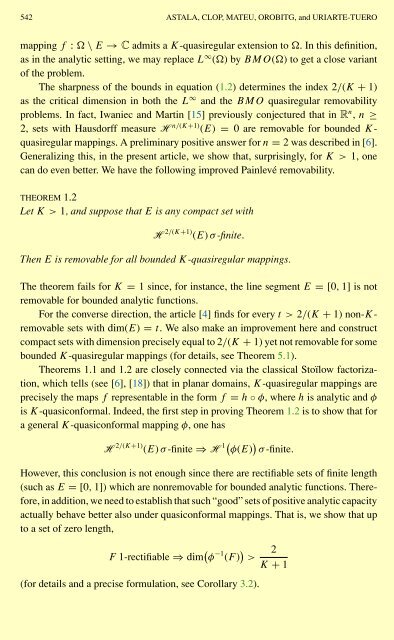A NULLSTELLENSATZ FOR AMOEBAS
A NULLSTELLENSATZ FOR AMOEBAS
A NULLSTELLENSATZ FOR AMOEBAS
Create successful ePaper yourself
Turn your PDF publications into a flip-book with our unique Google optimized e-Paper software.
542 ASTALA, CLOP, MATEU, OROBITG, and URIARTE-TUERO<br />
mapping f : \ E → C admits a K-quasiregular extension to . In this definition,<br />
as in the analytic setting, we may replace L ∞ () by BMO() to get a close variant<br />
of the problem.<br />
The sharpness of the bounds in equation (1.2) determines the index 2/(K + 1)<br />
as the critical dimension in both the L ∞ and the BMO quasiregular removability<br />
problems. In fact, Iwaniec and Martin [15] previously conjectured that in R n , n ≥<br />
2, sets with Hausdorff measure H n/(K+1) (E) = 0 are removable for bounded K-<br />
quasiregular mappings. A preliminary positive answer for n = 2 was described in [6].<br />
Generalizing this, in the present article, we show that, surprisingly, for K>1, one<br />
can do even better. We have the following improved Painlevé removability.<br />
THEOREM 1.2<br />
Let K>1, and suppose that E is any compact set with<br />
H 2/(K+1) (E) σ -finite.<br />
Then E is removable for all bounded K-quasiregular mappings.<br />
The theorem fails for K = 1 since, for instance, the line segment E = [0, 1] is not<br />
removable for bounded analytic functions.<br />
For the converse direction, the article [4] finds for every t>2/(K + 1) non-Kremovable<br />
sets with dim(E) = t. We also make an improvement here and construct<br />
compact sets with dimension precisely equal to 2/(K + 1) yet not removable for some<br />
bounded K-quasiregular mappings (for details, see Theorem 5.1).<br />
Theorems 1.1 and 1.2 are closely connected via the classical Stoïlow factorization,<br />
which tells (see [6], [18]) that in planar domains, K-quasiregular mappings are<br />
precisely the maps f representable in the form f = h ◦ φ, where h is analytic and φ<br />
is K-quasiconformal. Indeed, the first step in proving Theorem 1.2 is to show that for<br />
a general K-quasiconformal mapping φ, one has<br />
H 2/(K+1) (E) σ -finite ⇒ H 1( φ(E) ) σ -finite.<br />
However, this conclusion is not enough since there are rectifiable sets of finite length<br />
(such as E = [0, 1]) which are nonremovable for bounded analytic functions. Therefore,<br />
in addition, we need to establish that such “good” sets of positive analytic capacity<br />
actually behave better also under quasiconformal mappings. That is, we show that up<br />
to a set of zero length,<br />
F 1-rectifiable ⇒ dim ( φ −1 (F ) ) > 2<br />
K + 1<br />
(for details and a precise formulation, see Corollary 3.2).
















